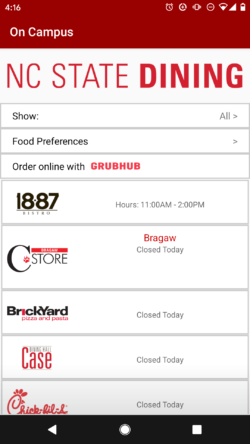Tips and Tricks for Eating on Campus with Type One Diabetes
Tips and Tricks for Eating on Campus with Type One Diabetes
By Brynn Lemmon, Nutrition Science class of 2022
Entering the dining hall for the first time is daunting for anyone. Throw being a diabetic into the mix, and it’s even more daunting. Surrounded by so many choices of food, having to guess carb counts, and figuring out how walking around campus will affect your post meal blood sugars is enough to stress anyone out. Here are my top 5 tips to make dining on campus with diabetes a little bit easier.
 1. Plan ahead. Utilize NC State’s “On Campus” app to view the menu options before arriving. Plan out what your meal will consist of, so when you arrive you can get exactly what you know you want and not be tempted to add extra things to your plate.
1. Plan ahead. Utilize NC State’s “On Campus” app to view the menu options before arriving. Plan out what your meal will consist of, so when you arrive you can get exactly what you know you want and not be tempted to add extra things to your plate.
2. Don’t be afraid to be proactive. If you are unsure of the nutritional content of something, don’t be afraid to ask the dining staff. Advocating for yourself and ensuring you have your carb count correct before giving insulin will lessen your risk of going low or high after your meal.
 3. Have a good balance of carbohydrates, protein, and fat. When eating a meal rich in carbohydrates, I’ve found my blood sugar spikes much less and remains steadier when I have a good source of protein and fat to accompany my meal. A good example is pairing a piece of chicken or salmon with high glycemic foods like rice or potatoes. Some avocado, cheese, or peanut butter would be a great source of fat. Some other options of foods that have both fat and protein are hummus, eggs, or full-fat Greek yogurt.
3. Have a good balance of carbohydrates, protein, and fat. When eating a meal rich in carbohydrates, I’ve found my blood sugar spikes much less and remains steadier when I have a good source of protein and fat to accompany my meal. A good example is pairing a piece of chicken or salmon with high glycemic foods like rice or potatoes. Some avocado, cheese, or peanut butter would be a great source of fat. Some other options of foods that have both fat and protein are hummus, eggs, or full-fat Greek yogurt.
4. Make sure you have a vegetable in your meal. Eating vegetables before or with a starch can flatten your glucose curve and prevent a post meal spike. We all know post meal spikes are followed by fatigue, headache, and then more hunger. I’ve found that when eating my greens with a food that has a high glycemic index, it makes my blood sugar very happy!
5. Be patient with yourself. Starting college causes a great deal of stress for anyone, let alone someone with a chronic illness. Understand that it may take weeks to months to figure out your new routine, get your insulin levels adjusted, and your blood sugars back in range. It won’t always be pretty, but I hope utilizing these small tips in the dining hall can help contribute to success.
For additional information about navigating college with Type One Diabetes, check out the resources below!
Tips for Going to College with Type 1 Diabetes
Diatribe: Tips for Heading to College with Type 1 Diabetes